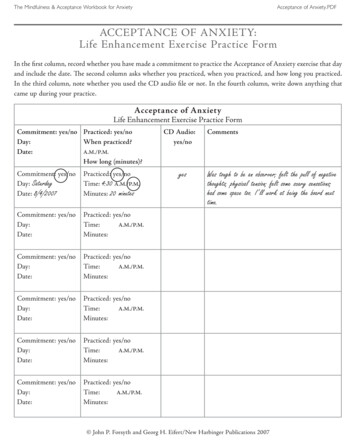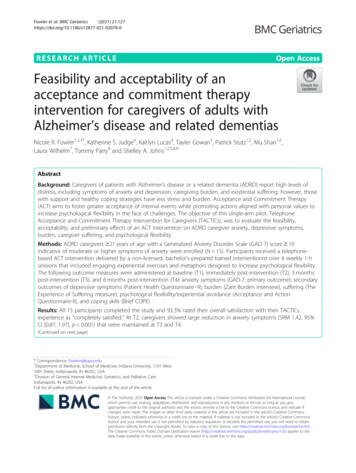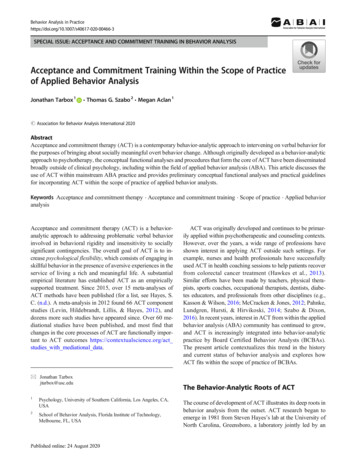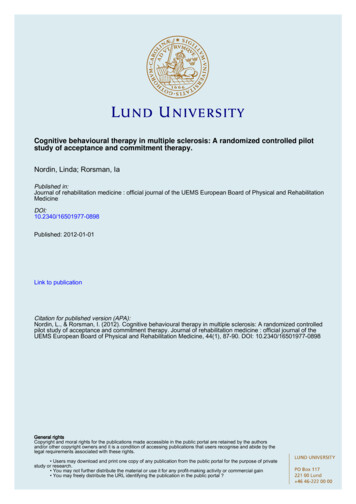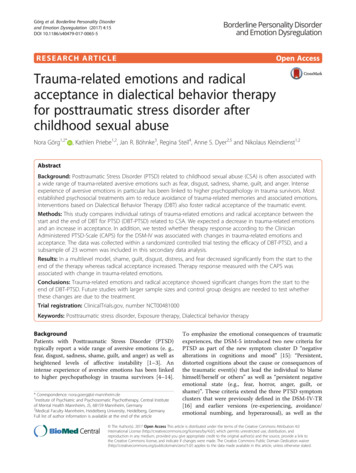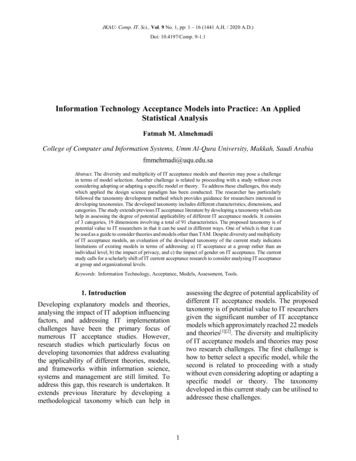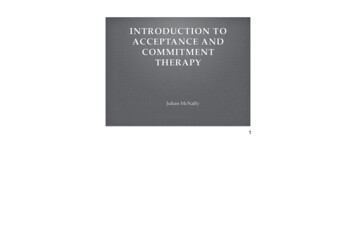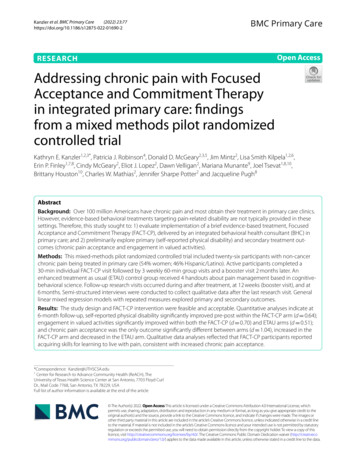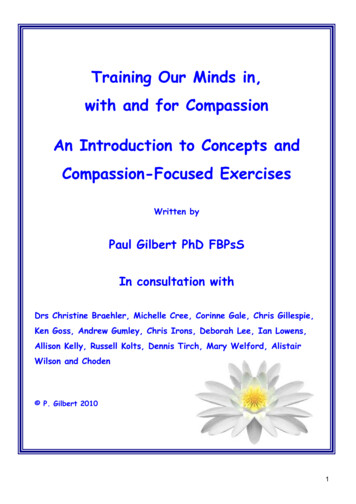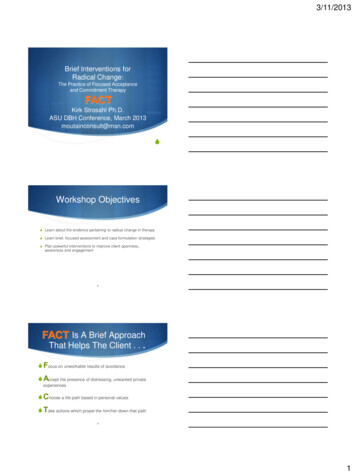
Transcription
3/11/2013Brief Interventions forRadical Change:The Practice of Focused Acceptanceand Commitment TherapyFACTKirk Strosahl Ph.D.ASU DBH Conference, March 2013moutainconsult@msn.com Workshop Objectives Learn about the evidence pertaining to radical change in therapy Learn brief, focused assessment and case formulation strategies Plan powerful interventions to improve client openness,awareness and engagement2FACT Is A Brief ApproachThat Helps The Client . . . Focus on unworkable results of avoidance Accept the presence of distressing, unwanted privateexperiences Choose a life path based in personal values Take actions which propel the him/her down that path31
3/11/2013FACT Assessment/Intervention FlowFunctionalAnalysis ofProblem(3 Ts Interview)ContextualFactors(Love, Work,Play, e”PsyFlexProfileFour SquareAnalysisRadicalChange!(Bulls EyePlanningTool; FACTQuickGuide)MotivationalIntervention:True North &Life Path4Why Brief Interventions? Practice ContextsAre Changing! More services delivered in brief intervention contexts such asprimary care, jails, schools, crisis units, home outreach services Conventional multi-session treatment protocols are not realisticin these settings Even in specialty treatment settings, resources are dwindlingwhile the number of clients needing services is expandingexponentially Requires that we condense assessment and treatment activities,empower clients and act more as a resource for the client ratherthan as a “therapist”5Brief Interventions:What Do Clients Want? In a naturalistic study of over 9000 patients in seekingtherapy, the modal number of psychotherapy visitswas one (Brown & Jones, 2004) Clients seek treatment when psychological distress ishigh and stop coming when distress level drops; formost this is within 5 visits (Brown & Jones, 2004) Their motives? Emotional reassurance and practicalproblem solving 30 to 40 percent drop out of treatment withoutconsulting their therapist (Talmon, 1990, Olfson et.al., 2009)62
3/11/2013Rapid Change is The Rule,Not the Exception!In one recent study, 40 to 45 percent of depressed clients exhibitedsudden large gains within the first 2 to 4 treatment sessions (Doane,Feeny & Zoellner, 2010)Similar gain in CBT for PTSD (52 percent of clients;Doane, Feeny & Zoeller, 2010), adolescent depression(Renaud et. al., 1998), binge eating (62 percent ofclients; Grilo, Masheb & Wilson, 2006) and irritablebowel syndrome (30 percent of clients; Lackner et. al.,2010)Rapid response is associated with long-termimprovements in functioning, as well as areduction in long term relapse rates (CritsCristoph et. al., 2001; Lutz, Stulz & Kock, 2009).7Change is a Non-Linear Process Studies of the “dose-effect” relationship (i.e., number oftherapy sessions received relative to the amount of clinicalbenefit experienced) 15 percent of clients are clinically improved before they arrivefor the first session! 50 percent of all clients are clinically improved by the 8thsession To get 75 percent of clients clinically improved requires atleast 26 sessions Conclusion: Treatment beyond session 8 is no wherenear as cost effective as the first 8 sessions! (Howard, Kopta,Krause & Orlinsky, 1986)8Is More Necessarily Better? Greatest amount of improvement occurs very early intreatment with diminishing returns of benefit over time.(Kopta ea al.; Ilardi & Craighead, 1994) Lengthier, time-unlimited therapies do not alwaysdemonstrate incremental efficacy compared to brieftherapies (Knekt et al., 2008; cf. Steenbarger, 1994 for areview)93
3/11/2013Recent Studies of BriefInterventions Patients show clinically significant change across very fewtreatment sessions (Bryan et al., 2009; Bryan et al., 2010;Cigrang et al., 2006) Patient receiving 2 or more sessions showed broad spectrumimprovements in symptoms, functioning and social integration(Bryan et. al. 2010) These changes were robust and stable during a two year followup period (Ray-Sannarud et. al., 2012) Patients with more severe impairment at pre-treatment improvedfaster than patients with less severe impairment (Bryan et al.,2012)10ASSUME 1 VISIT, HOPE FOR 4 - 6 Fact Mantra: Treat every session as if it is the lastsession! A “brief therapy” is one that can achieve its’ goals beforethe client’s natural tendency to drop out is realized. The change process begins in the first visit. Talking in rapid change terms is likely to induce rapidchange. Clients with long-standing problems are just as likely toexperience rapid change as those with time limitedproblems!11Why is the ACT Approach Idealfor Brief Therapy? Trans-diagnostic model of human suffering Strengths based approach to creating change (skill buildingrather than curing illnesses) Acceptance and mindfulness are “qualitative” processes that caninstantly transform a situation Values and committed action are powerful motivational tools The ACT approach is very transparent and the core concepts areeasily understood by non-mental health professionals124
3/11/2013Learn To Conduct A Streamlined,Change-Oriented Interview1.Quick, Focused, Accurate AssessmentTemplates Love, Work, Play & Health Questions Three Ts Problem Severity, Confidence, andHelpfulness Assessment Questions13The Love, Work, Play & Health QuestionsLoveWhere do you live? With whom? How long have you beenthere? Are things okay at your home? Do you have lovingrelationships with your family or friends?WorkDo you work? Study? If yes, what is your work? Do youenjoy it? If no, are you looking for work? If no, how do yoursupport yourself?PlayWhat do you do for fun? For relaxation? For connectingwith people in your neighborhood or community?HealthDo you use tobacco products, alcohol, illegal drugs? Doyou exercise on a regular basis for your health? Do youeat well? Sleep well?14The Three T & Workability QuestionsTimeWhen did this start? How often does it happen? Whathappens immediately before / after the problem? Whydo you think it is a problem now?TriggerIs there anything--a situation or a person--that seemsto set it off?TrajectoryWhat’s this problem been like over time? Have therebeen times when it was less of a concern? More of aconcern?Workability What have you tried (to address the problem)? Howhas that worked in the short run? In the long run or inthe sense of being consistent with what really mattersto you?155
3/11/2013FACT Visit Assessment Questions1. How big of a problem is2. How confident are youthis for you? On a scale ofthat you will follow0 “not a problem” andthrough with our plan?10 “a very big problem”,Use a scale where 0 how would you rate it?“no confidence” and 10 “very confident”.3. How helpful was thisvisit? Use a scale where0 “not helpful” and 10 “very helpful”.16Workability: The Central Question Has what you have been doing helped you getto where you want to be according to yourvalues?17Workability: Focus Questions1. What are you seeking?2. What have you tried?3. How has it worked?4. What has it cost you?5. What type of life would you choose if you couldchoose?186
3/11/2013The “Reframe” Often functions as the transition between assessment andintervention phase of a session Three main components Redefine the “problem” in a new way that the client hasn’tthought of before Creates a positive, intentional path for the client to follow Makes the “problem” seem solvable19Reframe Strategies Go to “30,000 feet” and portray the problem in terms of abigger life path the client is following Focus the discussion on the positive, value basedintentions of the client, rather than on what is not working Describe the necessity of the “problem” in teaching theclient about self or life State your confidence that the client is about to learnsomething important and will do things differently20The Pillars of FlexibilityOpenAwareEngaged Able to acceptdistressingmaterial withoutstruggle Able to Strongexperienceconnection withpresent moment values Behavior isshaped by directresults ratherthan rigid rules Able to takeperspective onself and selfstory Able to sustainvalue-consistentaction217
3/11/2013Flexibility Profile22Foursquare Tool Simple way to describe client strengths and weaknessesand to focus therapeutic interventions Creates distinction between target behaviors and mentalprocesses that enable (or disable) them Often, planning a target behavior will also require work ona mental process that is functioning as a barrier to thatbehavior23FACTFour SquareAnalysis248
3/11/2013Bulls Eye Planning Tool32ValueAction Steps:1.Relates to which core processes?2.Relates to which core processes?25Living the LifeI Choose26Life Path Graphic279
3/11/2013Life Path Questions28FACT Practice Support Tools:The Quick Guide 1 page pocket guide (put in on your wall, in your clipboard or in your pocket) 3 interventions for each of the 6 Processes / Pointsof Psychological Flexibility Categorized by Process / Point Bulls Eye involves multiple processes, as do several others29FACT ResourcesAssociation for Contextual Behavioral -in-primarycare.html3010
3/11/2013FACT Resources3111
The Practice of Focused Acceptance and Commitment Therapy FACT Kirk Strosahl Ph.D. ASU DBH Conference, March 2013 moutainconsult@msn.com 2 Workshop Objectives Learn about the evidence pertaining to radical change in therapy Learn brief, focused assessment and case formulation strategies

